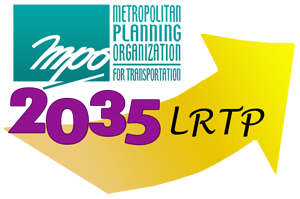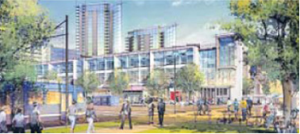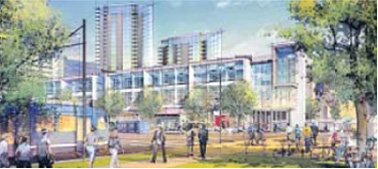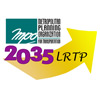 The 2035 Long Range Transportation Plan (LRTP) is a multi-modal plan full of choices that reflect and support the way we want to live and travel.
The 2035 Long Range Transportation Plan (LRTP) is a multi-modal plan full of choices that reflect and support the way we want to live and travel.
We are well-connected among places where people live, work, shop, and play in the Tampa Bay region.
Our accessible streets are lined with green and paved with space for people, bicycles, and motorized vehicles alike.
We have a variety of transportation choices, including rail, bus rapid transit, and other multimodal options.
We share rides, bike and walk securely, and deliver goods safely and on time.
We support local neighborhoods and the business community while competing in the global economy with our world-class port and aviation facilities.
Looking 25 years into the future, visualize a Tampa Bay where you can choose how you want to get around, whether it’s walking, biking, driving, taking a bus, train, or even a ferry.  Where communities are walkable and inviting, where you can breathe easier knowing we are taking care of the environment, where it’s safe to let your kids walk or ride their bikes to school. That’s a place where we want to be and where we want our children to grow up. To achieve this quality of life, we must look at how we grow and how we are connected.
Where communities are walkable and inviting, where you can breathe easier knowing we are taking care of the environment, where it’s safe to let your kids walk or ride their bikes to school. That’s a place where we want to be and where we want our children to grow up. To achieve this quality of life, we must look at how we grow and how we are connected.
The 2035 Long Range Transportation Plan is a multi-modal plan full of choices that reflect and support the way we want to live and travel.
View amendments and modifications to the 2035 Plan.
[one_half_first]
2035 Plan Document
- 2035 Plan Summary Brochure
- 2035 Plan Summary Brochure en Espanol
- 2035 Plan Cover, Contents and Introduction
- Chapter 1 Goals Objectives Policies
- Chapter 2 Public Engagement
- Chapter 3 Planning for Growth
- Chapter 4 Freight Mobility & Intermodal Transportaiton
- Chapter 5 Transportation Safety & Security
- Chapter 6 Regional Transportation
- Chapter 7 Environmental Considerations
- Chapter 8 Congestion Management and Alternatives to Driving
- Chapter 9 Financial Plan and Prioritization of Needs
- Chapter 10 Cost Affordable Plan
- Combined Appendices as of 12-14-2012
Maps of Affordable Projects
- Bike and Trail Projects
- Highway Projects by 2025
- Highway Projects by 2035
- Pedestrian & Sidewalk Projects
- Intelligent Transportation System Projects
- Transit Projects
- Future Transit Level of Service
Lists of Affordable Projects by Time & Fund
- Highway, Bicycle & Pedestrian Projects (Modified December 14, 2012)
- Transit Projects (Modified Sept. 1, 2010)
- Summary of Revenue Sources (Modified December 14, 2012)
Lists of Affordable & Unfunded Projects
- Affordable Highway Projects & Unfunded Needs (Modified December 14, 2012)
- Affordable Transit Projects & Unfunded Needs (Amended Sept. 1, 2010)
- Affordable Bike Projects & Unfunded Needs (Amended Sept. 11, 2012)
- Affordable Pedestrian Projects & Unfunded Needs (Amended Aug. 3, 2010)
[/one_half_first]
[one_half]
What’s in the Plan – By Area
- 2035 Plan Projects in Brandon, Palm River & Riverview
- 2035 Plan Projects in Central Tampa
- 2035 Plan Projects in Downtown Tampa
- 2035 Plan Projects in West Tampa, Westshore & Drew Park
- 2035 Plan Projects in East Tampa
- 2035 Plan Projects in New Tampa, USF area & Temple Terrace
- 2035 Plan Projects in Northwest Hillsborough County
- 2035 Plan Projects in East Hillsborough County & Plant City
- 2035 Plan Projects in South Tampa
- 2035 Plan Projects in Southshore & South Hillsborough County
What’s Behind the Plan – Technical Memos
- Comparison of Goals & Objectives with Federal Requirements
- MPO Public Participation Plan
- Public Engagement Technical Memorandum
- Socioeconomic Data Forecasts
- Socioeconomic Projections Methodology
- Reasonably Available & New Revenue Sources for the 2035 Plan
- Assessment of Economic Trends and Transportation Needs in the 2035 Plan
- Economic Evaluation of the 2035 Plan
- 2035 Plan Sustainabililty and Greenhouse Gas Reduction Strategies
- Freight Mobility Technical Memorandum
- Safety Technical Report
- Security Technical Report
- Efficient Transportation Decision Making – Environmental Screening Results of Candidate Projects in 2035 Plan
- Needs Assessment Cost Estimates
- Analysis of Greenhouse Gas Reduction from Implementing the 2035 Plan
- Transit Level of Service Evaluation – Existing Conditions
- Transit Level of Service Evaluation – 2035 Conditions
Transit Needs Assessment Segment Summaries (2010)
- Downtown_Tampa_to_South_Tampa
- Downtown_Tampa_to_Airport
- Downtown_Tampa_to_USF
- USF_to_Wesley_Chapel
- Westshore_to_Pinellas_County
- Brandon_to_Downtown_Tampa
- Busch_Linebaugh_East
- Busch_Linebaugh_West
- Carrollwood_Village_to_Airport
[/one_half]
_________________________________________________________________________________
 Looking 25 years into the future, visualize a Tampa Bay where you can choose how you want to get around, whether it’s walking, biking, driving, taking a bus, a train, or even a ferry. Where communities are walkable and inviting. Where you can breathe easier knowing we are taking better care of the environment. Where it’s safe to let your kids walk or ride their bikes to school. That is a place we want to be, and where we want our children to grow up. A place that has clean air, public spaces that evoke a strong sense of community, and sustainable resources that support a strong economy. To achieve this quality of life, we must look at how we grow and how we are connected.
Looking 25 years into the future, visualize a Tampa Bay where you can choose how you want to get around, whether it’s walking, biking, driving, taking a bus, a train, or even a ferry. Where communities are walkable and inviting. Where you can breathe easier knowing we are taking better care of the environment. Where it’s safe to let your kids walk or ride their bikes to school. That is a place we want to be, and where we want our children to grow up. A place that has clean air, public spaces that evoke a strong sense of community, and sustainable resources that support a strong economy. To achieve this quality of life, we must look at how we grow and how we are connected.
The Metropolitan Planning Organization is working with you to improve our livability, sustainability, mobility and accessibility. The vision for the future will include improvements in all types, or modes, of transportation, from walking and biking, to driving and riding on transit.
Visualize Transportation in 2035
https://archive.planhillsborough.org/whats-in-the-plan/
_________________________________________________________________________________
Save MONEY. $9,300.
Working families in our metro area spend about 1/3 of their household budget on transportation. That’s more than nearly any other region in the country. According to APTA, the American Public Transit Association, as of April 6, 2010, people who use public transportation can save up to $9,300 per year when you consider the cost of owning and operating a car. With more transportation choices available, many families would not have to own a second or third car. Some may even be able to not own a car at all!
Traffic RELIEF. $1,000,000,000.
Today, an average commuter in Tampa Bay spends an extra 46 hours per year sitting in traffic. This costs us a total of $1 billion annually. Even with the current slowdown of people moving to Florida, Hillsborough County is still growing and is expecting more than 500,000 new residents by 2035. With a 47% increase in population and 55% more jobs within Hillsborough County, the average delay on roadways will triple! In corridors where 8 new road lanes would be needed to meet this demand, rail is a cost effective strategy.
More JOBS. 47,500
An efficient transportation system is an economic engine and a job creator. Not only does transit attract new employers to our region – building it also creates jobs! According to APTA, for every billion dollars invested in public transportation, 47,500 jobs are supported, including construction, operations and maintenance, and secondary jobs from supplies and materials to feeding the hungry workers. For every dollar that’s invested in transit, research shows as much as $6 is generated in economic returns. In the economic times we are facing, that is a welcome statistic.
What is the Cost of Commuting?
Commuting Costs Can Negate Suburban Home Choices
By Shannon Behnken, The Tampa Tribune, 3/24/2010
Enticed by lower prices, many home buyers opt for long commutes to work, thinking it’s worth the drive to the suburbs. But that’s not always the case, according to a report from the Washington, D.C.-based nonprofit Center for Neighborhood Technology.
Problem is, according to the study, many are spending more on transportation than they figured and, consequently, the home isn’t affordable after all.
People in the Tampa-St. Petersburg-Clearwater metro area spend about $12,000 per household each year on transportation, the study said. (Those costs include car payments, gas and maintenance.) That’s a whopping $13 billion a year. “Tampa Bay has attracted people because of its affordable housing prices,” said Scott Bernstein, founder and president of the nonprofit. ”
But the fact is people there are spending a lot on transportation.
Why is this bad?
Tampa Bay households making the area’s median salary of $37,406 spend about 33 percent of their income on transportation and 25 percent on housing. Seventeen out of 28 regions studied spend more of their income on transportation than housing. The federal department of Housing and Urban Development recommends families spend no more than 30 percent of their income on housing.
“People seek locations to meet this goal, but they don’t take into account the cost of transportation,” said HUD deputy secretary Ron Sims. Using the 30 percent rule of thumb, the study shows, seven out of 10 U.S. communities, or 69 percent, are considered affordable. That shrinks to four out of 10, or 39 percent, when both housing and transportation costs are considered.
The nonprofit recommends families spend no more than 45 percent of their incomes on the two expenses.
So what should be done? The nonprofit urges governments to consider offering alternative means of transportation. Consumers, Bernstein said, should think about buying a home closer to work and shopping locations.
The nonprofit has also asked real estate agencies to include average transportation costs in home listings
___________________________________________________________________________________
[one_half_first] The 2035 Plan was adopted in 2009 but is a “living” document, meaning that it changes from time to time.
The 2035 Plan was adopted in 2009 but is a “living” document, meaning that it changes from time to time.
The MPO Board may formally amend the Plan at any time. On other occasions, staff may make administrative modifications.
[/one_half_first]
[one_half]
2035 LTRP Modifications December 2012
2035 LRTP Amendments Sept 2012
2035 LRTP Amendments Sept 2011
2035 LTRP Modifications July 2011
2035 LRTP Modification Sept 2010
[/one_half]

